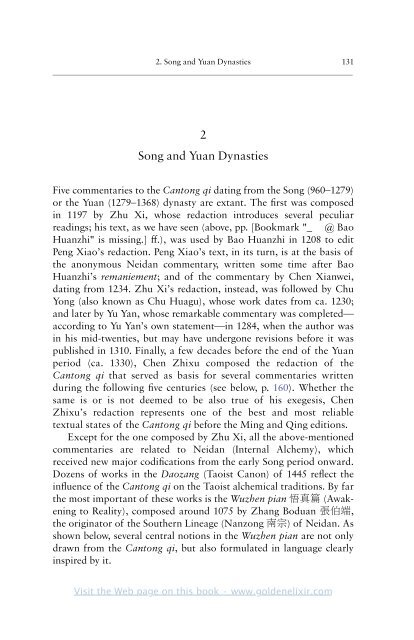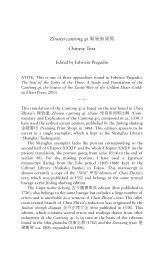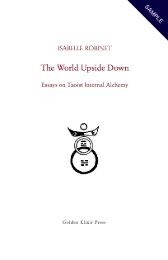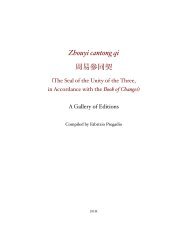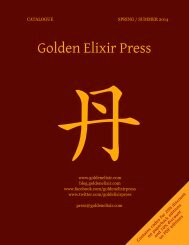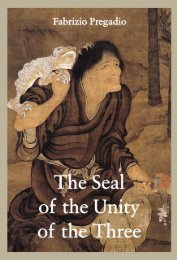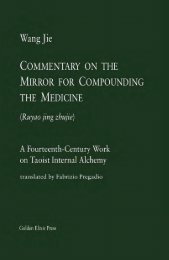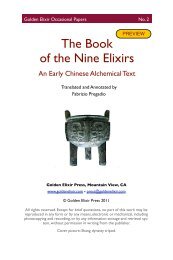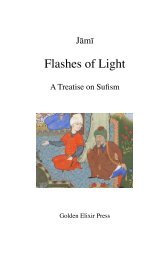The Seal of the Unity of the Three â Vol. 2 - The Golden Elixir
The Seal of the Unity of the Three â Vol. 2 - The Golden Elixir
The Seal of the Unity of the Three â Vol. 2 - The Golden Elixir
- No tags were found...
You also want an ePaper? Increase the reach of your titles
YUMPU automatically turns print PDFs into web optimized ePapers that Google loves.
2. Song and Yuan Dynasties 131<br />
—————————————————————————————————————————<br />
2<br />
Song and Yuan Dynasties<br />
Five commentaries to <strong>the</strong> Cantong qi dating from <strong>the</strong> Song (960–1279)<br />
or <strong>the</strong> Yuan (1279–1368) dynasty are extant. <strong>The</strong> first was composed<br />
in 1197 by Zhu Xi, whose redaction introduces several peculiar<br />
readings; his text, as we have seen (above, pp. [Bookmark "_ @ Bao<br />
Huanzhi" is missing.] ff.), was used by Bao Huanzhi in 1208 to edit<br />
Peng Xiao’s redaction. Peng Xiao’s text, in its turn, is at <strong>the</strong> basis <strong>of</strong><br />
<strong>the</strong> anonymous Neidan commentary, written some time after Bao<br />
Huanzhi’s remaniement; and <strong>of</strong> <strong>the</strong> commentary by Chen Xianwei,<br />
dating from 1234. Zhu Xi’s redaction, instead, was followed by Chu<br />
Yong (also known as Chu Huagu), whose work dates from ca. 1230;<br />
and later by Yu Yan, whose remarkable commentary was completed—<br />
according to Yu Yan’s own statement—in 1284, when <strong>the</strong> author was<br />
in his mid-twenties, but may have undergone revisions before it was<br />
published in 1310. Finally, a few decades before <strong>the</strong> end <strong>of</strong> <strong>the</strong> Yuan<br />
period (ca. 1330), Chen Zhixu composed <strong>the</strong> redaction <strong>of</strong> <strong>the</strong><br />
Cantong qi that served as basis for several commentaries written<br />
during <strong>the</strong> following five centuries (see below, p. 160). Whe<strong>the</strong>r <strong>the</strong><br />
same is or is not deemed to be also true <strong>of</strong> his exegesis, Chen<br />
Zhixu’s redaction represents one <strong>of</strong> <strong>the</strong> best and most reliable<br />
textual states <strong>of</strong> <strong>the</strong> Cantong qi before <strong>the</strong> Ming and Qing editions.<br />
Except for <strong>the</strong> one composed by Zhu Xi, all <strong>the</strong> above-mentioned<br />
commentaries are related to Neidan (Internal Alchemy), which<br />
received new major codifications from <strong>the</strong> early Song period onward.<br />
Dozens <strong>of</strong> works in <strong>the</strong> Daozang (Taoist Canon) <strong>of</strong> 1445 reflect <strong>the</strong><br />
influence <strong>of</strong> <strong>the</strong> Cantong qi on <strong>the</strong> Taoist alchemical traditions. By far<br />
<strong>the</strong> most important <strong>of</strong> <strong>the</strong>se works is <strong>the</strong> Wuzhen pian 悟 真 篇 (Awakening<br />
to Reality), composed around 1075 by Zhang Boduan 張 伯 端 ,<br />
<strong>the</strong> originator <strong>of</strong> <strong>the</strong> Sou<strong>the</strong>rn Lineage (Nanzong 南 宗 ) <strong>of</strong> Neidan. As<br />
shown below, several central notions in <strong>the</strong> Wuzhen pian are not only<br />
drawn from <strong>the</strong> Cantong qi, but also formulated in language clearly<br />
inspired by it.<br />
Visit <strong>the</strong> Web page on this book • www.goldenelixir.com


